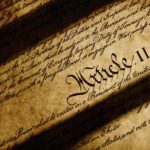In yesterday’s essay, I critiqued several well-known efforts to interpret our Constitution. The view that the Constitution evolves as judges invent new understandings of its terms falters, for the expansion of judicial power comes at the expense of judicial legitimacy. The text of the Constitution is not alone sufficient because the Constitution does not define its own terms. Interpretive methods that look to natural law and natural rights are grounded in the Constitution, but they are quite limited in practice. The Constitution is not, in Edward Corwin’s words, “a mystic overlaw.” The law of reason on which it is grounded requires specification in rules and judgments.
In today’s essay I argue that those rules and judgments are packed into the Constitution’s terms. For many of the terms of the Constitution are legal terms, pulled out of the common law.
The Constitution Incorporates Common Law
The Constitution does declare—identify and incorporate as it codifies—pre-positive law. The pre-positive law declared and codified in American constitutions, including the Constitution of the United States, is common law rather than abstract axioms or rights. It is “artificial reason,” in Coke’s famous phrase, perfected in the practice of righting wrongs over the course of centuries according to the reasonable customs and processes due to the English people and their former colonists in North America. The common law that founds our constitutionalism includes natural law and natural rights, but natural law is mostly settled and specified as concrete rights and duties by other aspects of common law: custom, maxims, precedents, and institutions of private and public ordering, such as ownership, contracts, juries, and legislatures.
Start your day with Public Discourse
Sign up and get our daily essays sent straight to your inbox.Pure reason by itself resolves very few constitutional questions. Most legal and constitutional issues are what Aquinas called matters of determination, partly shaped by enduring truths but largely open to being settled and specified in any number of equally reasonable ways. Borrowing from Aristotle, common law jurists call these matters of indifference. They understand that natural law is relevant to such questions, but it provides only a starting point. Additional determination is needed. And where people have promulgated a not-unreasonable settlement by custom, conveyance, agreement, rules of association, or legislation, the people’s settlement is entitled to be respected as law.
Of course, not all settlements can be justified in reason and some are contrary to it. Slavery is an obvious example. That is why common law is bounded by natural law even as it completes and perfects it. The American founding generation spoke of natural rights as being “engrafted into” the fundamental law of the British constitution, to which they made appeal in the Revolution. They thought of the “immutable laws of nature” and the ancient liberties of the British Constitution as both being foundational to North American law. And the great champions of our Constitution, when they engage in public discourse about it, often appeal directly to natural law and natural rights. John Adams, John Quincy Adams, Abraham Lincoln, Frederick Douglass, Martin Luther King, Jr., and many others have made constitutional arguments in terms of natural law and universal reason.
Great common law scholars such as the English jurist William Blackstone and the American jurist Joseph Story also taught that Hebrew scriptures and Christianity are part of the common law. The Ten Commandments are part of the common law, as is the Christian injunction to do unto others as we would have them do unto us. The Commandments are relatively determinate—you shall not murder or steal. So, the common law conclusively forbids intentional killing. It also remedies and sanctions taking or trespassing on another’s property without permission. Yet the common law also insists that entering another’s property is not trespassing when entry is necessary to save a human life.
The Golden Rule, by comparison, requires more specification. What I would have others do unto me depends on the context. So, the common law leaves most disputes for case-specific resolution by a jury of one’s peers, who hear all the evidence in a case and then render judgment about what was reasonable to do in the circumstances. The role of the jury is to distinguish between harmful self-interest on one hand and what reason requires or forbids on the other. All of this common law is packed into the Constitution’s guarantee that no person shall be deprived of life, liberty, or property without due process of law, and many other guarantees. Thus, the “background principles” to which Justice Scalia looked when interpreting the Constitution’s Takings Clause are the doctrines of the common law of wrongs (torts) and rights (property).
Common Law Supplies What Constitutional Interpretations Lack
Not only is common law the actual law of our Constitution, it remedies the defects that the other interpretations are supposed to fix. Common law institutions do the work that a Novelty Constitution is supposed to do. And common law institutions do that work better. Private property, contract, the criminal jury trial, the civil jury trial, and other common law institutions that the Constitution expressly preserves and secures, enable the law to develop gradually to meet human needs. But unlike the Novelty Constitution, they do not tear the law down. Instead, they grow the law and replenish it from within.
For example, property was once land and buildings and belonged to the wealthy. Now property includes movable items, money, shares of stock, inventions, songs, stories, works of art, and other things of value that people of all socioeconomic means can employ to enrich their own lives and the lives of others. That growth occurred over several centuries, as the law continually expanded economic opportunity for more and more people. And then the Framers of our Constitution declared and codified those developments in the intellectual property clause of Article I section 8, which unleashed unprecedented creativity, production, and prosperity in the United States.
Common law terms of art do the work that the text of the Constitution does not do, and was never intended to do, by itself. The Framers packed the common law into the Constitution by reference. The Constitution is full of terms taken directly out of common law treatises, statutes, and judicial precedents. The Constitution’s terms have determinate meanings not because the text defines them but rather because they are shorthand referents for entire bodies of legal doctrine that grew up in the common law and that continue to perform legal work today.
Common law maxims do the work that Axiomatic Constitutionalists attribute to axioms. Maxims are not abstract first principles but rather intermediate premises that summarize the practical wisdom accumulated in the common law. They are thus able to do what axioms cannot. For example, the common law maxim that nothing can be law that is contrary to reason rules out of bounds incoherent decisions and irrational acts while leaving to democratic and republican institutions the job of resolving questions about which reasonable minds can disagree. Most of the law of reason is at least partly indeterminate, matters of indifference. The common law makes reason more determinate by judgments that rely on precedents and legislative acts as evidence of what the law is and what it reflects about the practical wisdom of the people.
For example, conflicts between neighboring landowners over conflicting uses must be resolved reasonably. But what land uses are reasonable and which are unreasonable might vary from case to case. The common-law maxim that one must use one’s property so as not to cause harm to another’s property guides the practical deliberations of jurors as they decide whether a defendant’s use was unreasonable. But it does not by itself determine their verdict. That is why the judge instructs the jury about statutes and judicial precedents that give specific content to the common law of nuisance. By taking instruction from those rules and precedents, the jurors reason together with those who have come before, and so draw on the practical wisdom of the greater community.
The Fifth Amendment’s due process and takings clauses, which protect property from deprivation by the government, have all of that practical wisdom built into them. Both clauses use the term “property,” and property is an important liberty that is bounded and specified by the laws of trespass, nuisance, conveyance, gift, and other doctrines of the common law. When legislative, executive, and judicial officials act against property rights in disregard of common law, they act not only unwisely but also unlawfully.
American constitutions built on the common law also have an improvement on natural rights. We call them vested rights. Vested rights perform the practical work that natural rights cannot do by themselves. A vested right correlates with a concrete duty. When I use my land in a way that causes no nuisance to my neighbors, when I form a contract for the provision of lawful goods and services, and when I obtain a patent from the United States government, I obtain vested rights. Those rights impose concrete duties on my fellow citizens. And they impose an obligation on officials not to abrogate or impair my rights and my neighbor’s duties retrospectively, after the fact.
The Constitution: an Old Yet Young Document
So, our Constitution is both particular and universal, both young and ancient. Its rules and specifications change over time, but they were designed to change in keeping with the artificial reason and peculiar institutions of the common law. Our Constitution is both much younger and much older than 231 years.
The common law that our Constitution declares and the common-law rights and duties that it secures have a thousand-year history in England and the United States. And the common law incorporates elements that preceded it by several centuries more. Aspects of our Constitution can be traced back to ancient Babylon, Athens, and Jerusalem. In a sense, our constitution is universal.
Yet our Constitution is also not universal in an important sense. It is ours. It reflects our commitments as a people. We have chosen those norms and institutions that enable our people to flourish, such as private property and the jury trial. We have rejected those that suppress human creativity, such as monarchy. And we have abrogated those that are unjust, such as slavery and racial segregation.
We continue to disagree about matters of civic importance. And today our disagreements are often emotional and expressed with rancor. But understood as an expression of the common law commitments on which it was built, our Constitution still supplies common terms in which we might re-transform our civic discourse into something rational and productive.













